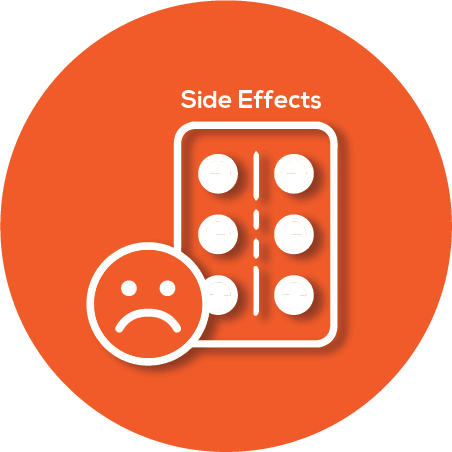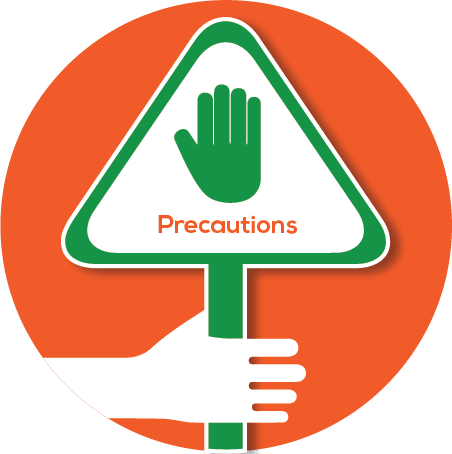Rabicer DSR 30mg/20mg Capsule DOMPERIDONE + RABEPRAZOLE
ABOUT RABICER DSR 30MG/20MG CAPSULE
Rabicer DSR 30mg/20mg Capsule is a brand name for the generic medicine(s) Domperidone (30mg) + Rabeprazole (20mg). This combination is primarily used to treat conditions related to the stomach and esophagus, such as gastroesophageal reflux disease (GERD) and peptic ulcer disease. These conditions are characterized by the backward flow of stomach acid into the esophagus, causing heartburn and irritation. Domperidone is a prokinetic agent that helps in increasing the movement of the stomach and intestines, allowing food to move more easily through the stomach. Rabeprazole is a proton pump inhibitor (PPI) that reduces the amount of acid produced in the stomach, providing relief from acid-related indigestion and heartburn.
Rabicer DSR 30mg/20mg Capsule is available in capsule form, making it easy to swallow and convenient for daily use. It is produced by Biochem Pharmaceutical Industries, a reputable manufacturer known for adhering to high-quality standards in pharmaceutical production. The company meets WHO Good Manufacturing Practice (GMP) certification criteria according to CDSCO, ensuring that the product is safe and effective for consumer use.
Alternatives to Rabicer DSR 30mg/20mg Capsule include other brands with the same composition, such as Domstal-RD, Rabekind-DSR, and Razo-D. These alternatives offer similar therapeutic benefits and can be considered if Rabicer DSR is not available or suitable for the patient.
INTRODUCTION OF RABICER DSR 30MG/20MG CAPSULE
Rabicer DSR 30mg/20mg Capsule is a potent medication designed to address the discomfort and complications associated with excessive stomach acid production and impaired gastrointestinal motility. This medication is particularly beneficial for individuals suffering from chronic conditions like GERD, where the esophagus is frequently exposed to stomach acid, leading to inflammation and pain. By combining the effects of Domperidone and Rabeprazole, Rabicer DSR not only alleviates symptoms but also promotes healing of the esophageal lining, thus preventing further damage.
The dual-action formula of Rabicer DSR 30mg/20mg Capsule ensures comprehensive management of acid-related disorders. Domperidone works by enhancing the motility of the gastrointestinal tract, which helps in faster gastric emptying and reduces the likelihood of acid reflux. On the other hand, Rabeprazole effectively suppresses gastric acid secretion, providing a soothing effect on the stomach lining and esophagus. This combination is particularly useful for patients who experience frequent heartburn, regurgitation, and other symptoms associated with acid reflux.
Patients using Rabicer DSR 30mg/20mg Capsule can expect significant relief from the discomfort of acid reflux and related symptoms. The medication is generally well-tolerated, with a favorable safety profile, making it a preferred choice for long-term management of acid-related disorders. However, it is essential for patients to follow their healthcare provider's instructions regarding dosage and duration of treatment to achieve optimal results and minimize potential side effects.
CONDITIONS TREATED BY RABICER DSR 30MG/20MG CAPSULE
Rabicer DSR 30mg/20mg Capsule is primarily used to manage conditions such as gastroesophageal reflux disease (GERD), peptic ulcer disease, and other acid-related disorders. It is effective in reducing symptoms like heartburn, acid regurgitation, and indigestion, providing relief and promoting healing of the gastrointestinal tract.
MOLECULE NAME
Domperidone (30mg) + Rabeprazole (20mg)
HOW IT WORKS RABICER DSR 30MG/20MG CAPSULE
Rabicer DSR 30mg/20mg Capsule works by combining the effects of two active ingredients: Domperidone and Rabeprazole. Domperidone acts as a prokinetic agent, enhancing the movement of the stomach and intestines, which helps in faster gastric emptying and reduces the risk of acid reflux. Rabeprazole, a proton pump inhibitor, reduces the production of stomach acid, providing relief from acid-related symptoms and promoting healing of the esophagus and stomach lining.
COMMON SIDE EFFECTS OF RABICER DSR 30MG/20MG CAPSULE
Common side effects of Rabicer DSR 30mg/20mg Capsule may include headache, dizziness, dry mouth, abdominal pain, diarrhea, and constipation. These side effects are generally mild and temporary, but if they persist or worsen, it is advisable to consult a healthcare professional.
HOW TO TAKE RABICER DSR 30MG/20MG CAPSULE
Rabicer DSR 30mg/20mg Capsule should be taken as directed by a healthcare provider. It is usually taken before meals to maximize its effectiveness. Swallow the capsule whole with a glass of water, and do not crush or chew it. Follow the prescribed dosage and duration of treatment to achieve the best results.
PRECAUTIONS OF RABICER DSR 30MG/20MG CAPSULE
Before taking Rabicer DSR 30mg/20mg Capsule, inform your healthcare provider about any allergies, medical conditions, or other medications you are taking. This medication should be used with caution in patients with liver or kidney impairment. Pregnant or breastfeeding women should consult their doctor before using this medication. Avoid alcohol consumption, as it may increase the risk of side effects.
FOOD & DRUG INTERACTIONS OF RABICER DSR 30MG/20MG CAPSULE
Rabicer DSR 30mg/20mg Capsule may interact with certain medications, such as ketoconazole, erythromycin, and anticoagulants. It is important to inform your healthcare provider about all the medications you are taking to avoid potential interactions. Avoid consuming alcohol and grapefruit juice, as they may interfere with the effectiveness of the medication.
ALTERNATIVE BRANDS OF RABICER DSR 30MG/20MG CAPSULE
Alternative brands with the same composition as Rabicer DSR 30mg/20mg Capsule include Domstal-RD, Rabekind-DSR, and Razo-D. These alternatives offer similar therapeutic benefits and can be considered if Rabicer DSR is not available or suitable for the patient.
FACT MEDICINE OF RABICER DSR 30MG/20MG CAPSULE
Rabicer DSR 30mg/20mg Capsule is a combination medication used to treat acid-related disorders. It contains Domperidone and Rabeprazole, which work together to enhance gastrointestinal motility and reduce stomach acid production. This medication is effective in managing symptoms of GERD and peptic ulcer disease, providing relief and promoting healing. It is manufactured by Biochem Pharmaceutical Industries, a company known for its adherence to high-quality standards.


Are the medicines in combination of Domperidone and Rabeprazole safe to take together?
Domperidone, which is a medication used to relieve nausea and vomiting, and Rabeprazole, which is a proton pump inhibitor used to reduce stomach acid, can be taken together without significant drug-drug interactions. However, it's important to monitor for any unusual symptoms. To monitor for interactions, keep an eye on any changes in how you feel after starting these medications. Look out for symptoms like increased heart rate, dizziness, or unusual fatigue. If you notice any of these, contact your healthcare provider. Regular check-ups with your doctor can help ensure that the medications are working as intended and that no interactions are causing problems. Your doctor may also recommend blood tests to check how your body is responding to the medications.

Are there harms and risks from taking combination of Domperidone and Rabeprazole?
Domperidone, which is used to relieve nausea and vomiting, can cause side effects like dry mouth, headache, and dizziness. A significant adverse effect is an increased risk of heart rhythm problems, which refers to irregular heartbeats. Rabeprazole, which is used to treat acid reflux and stomach ulcers, may cause side effects such as headache, diarrhea, and abdominal pain. A significant adverse effect is the potential for low magnesium levels, which can lead to muscle spasms or irregular heartbeats. Both medications can cause headaches as a common side effect. However, they have unique attributes: Domperidone is more associated with heart rhythm issues, while Rabeprazole can affect magnesium levels. It's important to consult a healthcare provider if you experience any severe or persistent side effects from either medication.

Can I take combination of Domperidone and Rabeprazole if I am pregnant?
Domperidone, which is used to relieve nausea and vomiting, is not recommended during pregnancy unless the benefits outweigh the risks. This is because there is limited information on its safety for pregnant women. Rabeprazole, which is used to treat acid reflux and heartburn, also lacks sufficient data on its safety during pregnancy. It is generally advised to use it only if necessary and under medical supervision. Both medications share the common concern of insufficient data regarding their safety in pregnancy, meaning they should be used cautiously. However, they are used for different conditions: Domperidone for nausea and vomiting, and Rabeprazole for acid-related issues. It is crucial for pregnant women to consult their healthcare provider before using either medication to ensure the safety of both the mother and the unborn child.

Can I take combination of Domperidone and Rabeprazole while breastfeeding?
Domperidone, which is a medication used to relieve nausea and vomiting, is generally considered safe during breastfeeding. It is known to pass into breast milk in small amounts, but it is unlikely to harm a nursing infant. However, it should be used under medical supervision, especially if the mother or baby has any health issues. Rabeprazole, which is a medication used to reduce stomach acid, is less commonly studied in breastfeeding women. It is believed to pass into breast milk in small amounts, but there is limited data on its effects on a nursing infant. Therefore, it is recommended to use it only if clearly needed and under medical advice. Both medications share the common attribute of being used to treat digestive issues, and both pass into breast milk in small amounts. However, Domperidone is more commonly considered safe for breastfeeding, while Rabeprazole requires more caution and medical guidance.

Can I take combination of Domperidone and Rabeprazole with other prescription drugs?
Domperidone, which is used to relieve nausea and vomiting, can interact with certain medications that affect heart rhythm, such as ketoconazole, which is an antifungal medication. This interaction can increase the risk of serious heart problems. Rabeprazole, which is used to reduce stomach acid, can interact with drugs like methotrexate, which is used to treat cancer and autoimmune diseases, potentially increasing methotrexate levels in the body. Both Domperidone and Rabeprazole can interact with medications that affect liver enzymes, which are proteins that help break down drugs in the body. This can alter the effectiveness of either drug. It's important to consult a healthcare provider before combining these medications with others. While Domperidone primarily affects the digestive system, Rabeprazole focuses on reducing stomach acid, but both require careful monitoring when used with other drugs.

For how long is combination of Domperidone and Rabeprazole taken?
Domperidone is typically used for short-term relief of nausea and vomiting, which are symptoms of feeling sick and throwing up. It is usually prescribed for a duration of up to one week. Rabeprazole, on the other hand, is used to treat conditions like gastroesophageal reflux disease (GERD), which is a long-term condition where stomach acid comes up into the esophagus. It is often used for longer periods, sometimes several weeks or months, depending on the condition being treated. Both medicines are used to address issues related to the digestive system. However, Domperidone works by speeding up the movement of the stomach and intestines, while Rabeprazole reduces the amount of acid produced in the stomach. They both aim to relieve discomfort but do so through different mechanisms and are used for different durations based on the condition being treated.

How does combination of Domperidone and Rabeprazole work?
Domperidone works by blocking dopamine receptors, which are proteins that help transmit signals in the brain and gut. This action helps to increase the movement of the stomach and intestines, allowing food to move more easily through the digestive system. It is often used to relieve symptoms of nausea and vomiting. Rabeprazole, on the other hand, is a proton pump inhibitor, which means it reduces the amount of acid produced in the stomach. It does this by blocking the enzyme in the stomach wall that produces acid. This helps to treat conditions like acid reflux and stomach ulcers. Both Domperidone and Rabeprazole help with digestive issues, but they work in different ways. Domperidone focuses on improving gut movement, while Rabeprazole reduces stomach acid production. Together, they can help manage symptoms related to digestion and stomach discomfort.

How does one take combination of Domperidone and Rabeprazole?
Domperidone, which is used to relieve nausea and vomiting, should be taken before meals. This is because it works best when taken on an empty stomach. Rabeprazole, which is used to reduce stomach acid, can be taken with or without food, but it is often recommended to take it before meals for optimal effect. Both medicines do not have specific food restrictions, but it is generally advised to avoid alcohol as it can irritate the stomach lining. Domperidone and Rabeprazole share the common goal of improving digestive comfort, but they work in different ways. Domperidone helps with movement in the digestive tract, while Rabeprazole reduces acid production. Always follow your healthcare provider's instructions when taking these medications.

How do I know if combination of Domperidone and Rabeprazole is working?
The benefits of Domperidone and Rabeprazole are measured by their ability to relieve symptoms and improve quality of life for people with digestive issues. Domperidone is used to treat nausea and vomiting, which are feelings of sickness and the act of throwing up, by helping the stomach move food more easily into the intestines. Rabeprazole is used to reduce stomach acid, which is a digestive fluid, and treat conditions like acid reflux, which is when stomach acid flows back into the food pipe causing heartburn. Both medicines aim to improve digestive comfort. They share the common goal of alleviating discomfort related to the digestive system, but they work in different ways. Domperidone focuses on enhancing stomach movement, while Rabeprazole reduces acid production. Their effectiveness is assessed by the reduction in symptoms and improvement in the patient's daily activities.

How do I store combination of Domperidone and Rabeprazole?
Domperidone and Rabeprazole do not require refrigeration. Both should be stored at room temperature, which means keeping them in a place that is not too hot or too cold, away from direct sunlight and moisture. Domperidone, which is used to relieve nausea and vomiting, should be kept in a tightly closed container to protect it from moisture. Rabeprazole, which is used to treat conditions like acid reflux by reducing stomach acid, should also be stored in a dry place. Both medications share the common attribute of needing to be kept out of reach of children to prevent accidental ingestion. It's important to follow any specific storage instructions provided by your pharmacist or on the medication packaging to ensure the medicine remains effective.

How effective is combination of Domperidone and Rabeprazole?
Domperidone is a medication that helps with nausea and vomiting, which are symptoms of feeling sick and the act of throwing up. It works by blocking dopamine receptors, which are parts of the brain that can trigger these symptoms. Rabeprazole, on the other hand, is used to treat conditions like acid reflux, which is when stomach acid flows back into the food pipe, causing heartburn. It works by reducing the amount of acid the stomach makes. Both Domperidone and Rabeprazole are used to treat digestive issues, which are problems related to the stomach and intestines. They are often prescribed together to help manage symptoms more effectively. While Domperidone focuses on reducing nausea, Rabeprazole helps in controlling stomach acid. Together, they provide a comprehensive approach to managing digestive discomfort.

How long does it take for combination of Domperidone and Rabeprazole to work?
The time it takes for a combination medicine to start working depends on the individual medicines involved. For example, if the combination includes ibuprofen, which is a pain reliever and anti-inflammatory drug, it typically starts working within 20 to 30 minutes. On the other hand, if the combination includes acetaminophen, which is another pain reliever, it usually begins to work within 30 to 60 minutes. Both medicines are used to relieve pain and reduce fever, which means they share these common attributes. However, ibuprofen also reduces inflammation, which is swelling and redness, while acetaminophen does not. When combined, these medicines can provide a broader range of pain relief and fever reduction, often starting to work within 30 to 60 minutes, depending on the specific combination and individual response.

What disease or symptom is combination of Domperidone and Rabeprazole used for?
Domperidone is used to treat nausea and vomiting, which are symptoms of feeling sick and throwing up. It works by helping the stomach to empty more quickly and by increasing the movement of the intestines. Rabeprazole is used to treat conditions like gastroesophageal reflux disease (GERD), which is a long-term condition where stomach acid comes up into the esophagus causing heartburn, and ulcers, which are sores on the lining of the stomach or intestines. Rabeprazole works by reducing the amount of acid the stomach makes. Both Domperidone and Rabeprazole can be used to help with digestive issues, but they work in different ways. Domperidone helps with the movement of food through the stomach, while Rabeprazole reduces stomach acid. They are often used together to provide relief from symptoms related to stomach and digestive problems.

What is combination of Domperidone and Rabeprazole?
Domperidone is commonly used to relieve nausea and vomiting, which are symptoms of an upset stomach, by blocking dopamine receptors in the gut that trigger these symptoms. Rabeprazole is used to treat conditions like acid reflux, which is a condition where stomach acid flows back into the esophagus, by reducing the amount of acid produced in the stomach. Both medicines help with digestive issues but work in different ways; Domperidone affects the movement of the stomach and intestines, while Rabeprazole reduces stomach acid production. They share the common goal of improving digestive health but target different aspects of the digestive process.

What is the usual dose of combination of Domperidone and Rabeprazole?
The usual adult daily dose for Domperidone, which is a medicine used to relieve nausea and vomiting, is typically 10 milligrams taken up to three times a day. Rabeprazole, which is a proton pump inhibitor used to reduce stomach acid, is usually taken as a 20 milligram dose once daily. Domperidone works by blocking dopamine receptors, which are proteins that help transmit signals in the brain, in the gut to speed up the movement of food through the stomach. Rabeprazole, on the other hand, works by blocking the proton pump, which is an enzyme in the stomach lining that produces acid, to reduce acid production. Both medicines are used to treat conditions related to the stomach and digestive system. They are often prescribed together to manage symptoms like nausea and acid reflux, which is a condition where stomach acid flows back into the esophagus.

Who should avoid taking combination of Domperidone and Rabeprazole?
Domperidone, which is used to relieve nausea and vomiting, should not be used by people with heart conditions, as it can cause serious heart rhythm problems. It is also not recommended for those with liver problems. Rabeprazole, which reduces stomach acid, should be used cautiously by people with liver disease and may increase the risk of bone fractures if used long-term. Both medicines should be avoided during pregnancy and breastfeeding unless advised by a doctor. They share a common warning of potential interactions with other medications, so it is important to inform your healthcare provider about all medicines you are taking. Additionally, both should be used with caution in older adults due to increased sensitivity to side effects. Always follow your healthcare provider's instructions when using these medications.















.svg)
